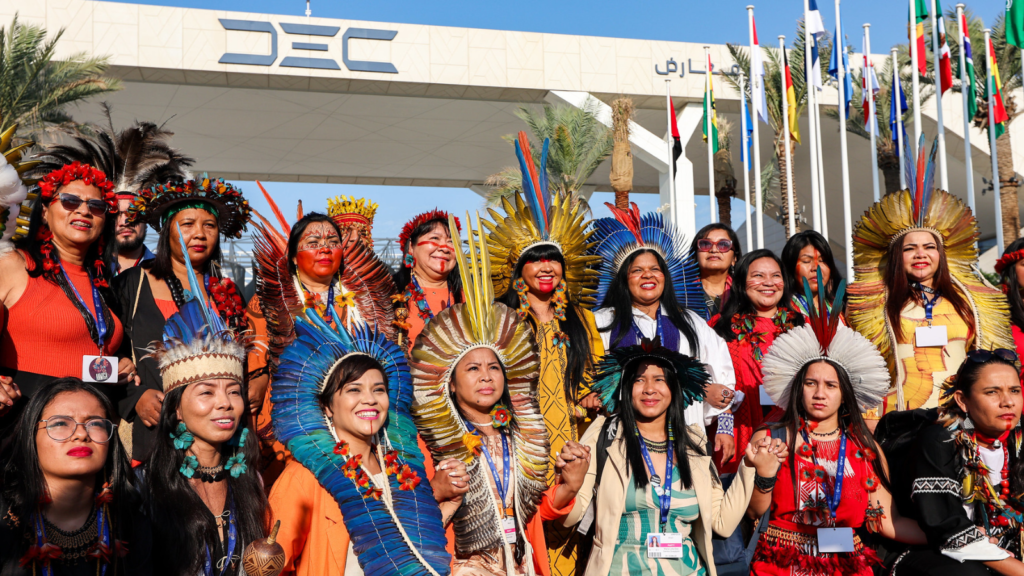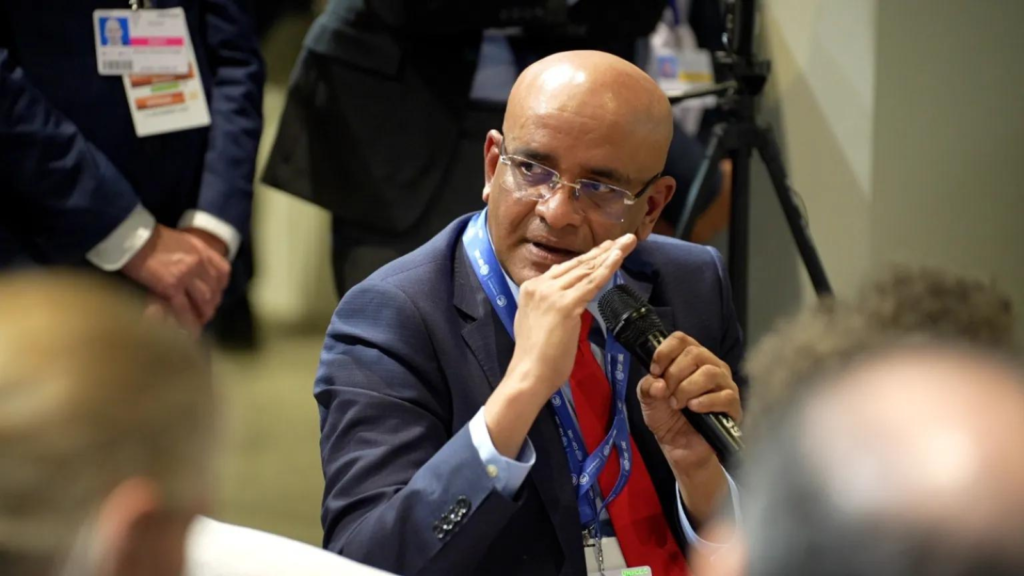Will saving trees help save the planet?
It sounds like an obvious question. And it’s more obvious that trees are an essential part of saving the earth and its inhabitants from the climate crisis. After all, trees help to trap carbon dioxide, a harmful greenhouse gas that contributes to global warming, and more frequent and extreme natural disasters like floods and fires.
Guyana’s leaders certainly think protecting these trees is important, so much so that for years, the country maintained its forests, which cover about 85% of its landmass. About 18.5 million hectares of forests are largely untouched, storing about 19.5 gigatonnes of carbon and providing a home to a countless number of plant and animal species.
Those forests are also needed by the country’s indigenous people, nine distinct tribes united in their harmonious relationship with nature.

“The problem, globally, is that we don’t see enough attention on forests,” the country’s Vice President, Dr. Bharrat Jagdeo, said at this year’s United Nations (UN) climate talks, COP28, in Dubai. “Somehow, there is a belief that forests can be saved through philanthropy or pledges like Glasgow [the COP26 Glasgow Declaration on Forests and Land Use].”
Jagdeo, a former President and Champion of the Earth who rolled out Guyana’s plan to earn from protecting its forests more than a decade ago said this at Guyana’s side event at COP28. The plan he rolled out is called the Low Carbon Development Strategy (LCDS). In 2009, Guyana used this plan to secure US$250 million from Norway to keep its vast forests intact.
In 2021, Guyana’s President, Dr. Irfaan Ali, revitalised the plan and updated it to reflect Guyana’s development trajectory since the 2000s. Now, it includes the blue economy, Guyana’s energy transition plan, and carbon credits.

The argument has always been simple: Guyana’s trees help save the earth, so Guyana should be paid to keep those intact.
That’s the main argument behind the country’s decision to get into the carbon market now.
And as of December 2022, just after Guyana got the world’s first jurisdictional credits issued to it, the country inked a massive deal, selling 30% of its credits for at least US$750 million to American oil company Hess Corporation up to 2030. Of the proceeds, 15% goes to the more than 240 Indigenous communities across the country, while the remaining 85% is to invest in national priorities, especially those that help with climate adaptation, like massive drainage canals.
Guyana is participating in COP28 with the hopes of convincing more countries or companies to buy into the carbon credits venture.

Jagdeo and President Ali both highlighted that Guyana still needs more money to fund its development and to counter the climate disasters it faces, be it flooding along its below-sea-level coast or wildfires ripping through its forests because of the hot temperatures this year. It hopes the carbon credits venture will help.
But the Vice President contended that tackling deforestation by outcompeting alternate uses of forests—the motive of the carbon credits venture—is one of the solutions to the climate crisis that just doesn’t get enough attention.
Jagdeo essentially asks: Without efforts to outcompete deforestation meant to make way for mining or agriculture, for example, how do you convince countries not to cut down their trees?
“Solutions that often are provided by our forest, somehow, in the developed world, they believe those should be done for free,” he lamented.

An oily pursuit?
The country’s president pushed the conversation a bit further, venturing into oily territory. That is, he spoke about the oil sector, an industry notorious for producing fossil fuels that result in huge amounts of greenhouse gas emissions when used.
President Ali believes the narrow focus on slashing fossil fuels means that many may lose sight of the other solutions that must be pursued too, like saving the forests. “We moved the discourse on net zero from ‘How do we get to net zero by 2050?’ to ‘How do we end petroleum?’ Because of that, we haven’t been able to squeeze the oil players to invest in technologies like carbon capture,” the president said.
He clarified that he isn’t against reducing fossil fuel use, as Guyana supports the removal of fossil fuel subsidies and wants more investments in renewable energy sources. As long as an unmet energy demand exists, though, Dr. Ali doesn’t think the hyperfocus on fossil fuel cuts augurs well for earth-saving efforts.

That isn’t the whole story, though. Guyana is among the world’s newest oil and gas producers, and its prolific Stabroek Block, with about 11 billion barrels of recoverable oil found so far, makes it a global hotspot. The crude oil there is of light, sweet quality, making it easier to process and more attractive in the marketplace.
Because of this, and because Guyana thinks it deserves the chance to harness its (oil) resources, it wants to be one of the countries still supplying oil even after the expected major fossil fuel cuts.
Asked pointedly if Guyana’s pursuit is a case of hypocrisy, the president said, “No.”
“We have made it very clear that we are going to develop the sector… but we are still going to be (carbon negative),” Dr. Ali said.
He means that Guyana’s vast forests will still offset more emissions than those produced by the oil and gas sector. And he asked, “Isn’t it hypocrisy (sic) for the developed world to ask the developing world to keep the forests standing with no compensation?”
Vice President Jagdeo explained that even when Guyana gets to peak oil production, that is, 1.6 million barrels of oil per day, the country will only be emitting harmful gases that are about 20% of the amount of gases trapped by local forests.
They both keep circling back to the same point, which is that Guyana’s forests are important and valuable, so they must attract compensation. The carbon credit market, Jagdeo added, is a necessary venture due to the lack of public finances for compensation.
Market under scrutiny
Carbon markets aren’t without scrutiny. There are huge concerns about greenwashing and the venture’s failures at preventing deforestation in some countries.
Article 6 of the Paris Agreement sets out the principles for carbon markets so that countries can move closer to their climate targets, but negotiations on rules for the markets, which are both voluntary and compliance-driven, continue at COP28. Good practices for voluntary carbon markets were proposed in Dubai on Sunday by the International Organization of Securities Commissions (IOSCO).
Camilo Trujillo, a technical analyst with the International Emissions Trading Association (IETA) for Latin America, told Climate Tracker that the creation of these standards has been a conversation for years because many want the venture to be accountable, but there are many moving parts.
“It is something that is evolving all the time because sometimes you have new kinds of projects that will reduce emissions,” he said.
He added, “… the carbon credit market is evolving each time, even more, to have technology into the process and have more integrity and accuracy of the emissions that are reduced or removed in the projects and also having better data to create better carbon credits.”
Still, he pointed out that there are core carbon credit principles set as a global benchmark for high-integrity credits. If followed, he believes carbon credit projects in Guyana or elsewhere would be successful in helping to reduce harmful emissions by supporting forest protection.
Interestingly, Jagdeo boasted that Guyana’s carbon credits and wider, the LCDS, “answer all the questions and things that people raise globally,” be it tracking or accountability.
“We have had 10 years of a robust Measurement, Reporting and Verification System (MRVS) tracking every change (in the forests). We have annual verifications, so you get what you pay for… and we have demonstrated that indigenous communities can be integrated and they can benefit,” the Vice President said.
It isn’t his word alone.
Some of what he said is acknowledged by the Organisation for Economic Co-operation and Development (OECD) in its 2023 report titled “Capacity Development for Climate Change in Small Island Developing States.”
According to that report, “Guyana established a comprehensive, robust, and advanced measurement, reporting, and verification system for Reducing Emissions from Deforestation and Forest Degradation (REDD+), which helped measure and report its forest carbon emissions. This contributed to a global understanding of how small, forested countries can reliably and cost-effectively measure and report on their forest carbon emissions.”

With some of the COP28 negotiations focused on Article 6, Guyana hopes for more support for carbon markets and, of course, higher prices for its remaining 70% of credits.
In the pursuit of safeguarding its vast forests, Guyana’s narrative on climate action extends beyond ecological considerations. It echoes the principles of climate justice. At the heart of this endeavour is the recognition of the integral role played by indigenous communities, whose harmonious relationship with nature is deeply intertwined with the forests. The commitment to allocate 15% of the proceeds from the carbon credit market directly to over 240 indigenous communities underscores dedication to rectifying historical environmental injustices. This approach not only acknowledges the indigenous peoples as stewards of the land but also seeks to empower them economically and socially.
Guyana’s leaders contend that their vision goes beyond safeguarding their territory; it stands as a call for global responsibility, challenging the developed world to recognise the worth of preserving forests and to ensure that such crucial conservation efforts are not borne solely by the nation with rich biodiversity. Guyana positions itself not only as a guardian of its ecosystems but as an advocate for an equitable and collaborative approach in the collective fight against climate change.
This story was published through Climate Tracker’s COP28 Climate Justice Reporting Fellowship, in partnership with Open Society Foundations